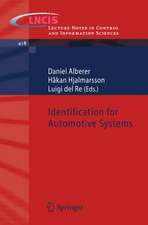Decision-Making Techniques for Autonomous Vehicles
Editat de Jorge Villagra, Felipe Jiménezen Limba Engleză Paperback – 9 mar 2023
- Provides a complete overview of decision-making and control techniques for autonomous vehicles
- Includes technical, physical, and mathematical explanations to provide knowledge for implementation of tools
- Features machine learning to improve performance of decision-making algorithms
- Shows how regulations and ethics influence the development and implementation of these algorithms in real scenarios
Preț: 803.47 lei
Preț vechi: 1052.07 lei
-24% Nou
Puncte Express: 1205
Preț estimativ în valută:
153.78€ • 159.94$ • 128.87£
153.78€ • 159.94$ • 128.87£
Carte tipărită la comandă
Livrare economică 06-20 martie
Preluare comenzi: 021 569.72.76
Specificații
ISBN-13: 9780323983396
ISBN-10: 0323983391
Pagini: 424
Ilustrații: Approx. 200 illustrations
Dimensiuni: 152 x 229 x 33 mm
Greutate: 0.57 kg
Editura: ELSEVIER SCIENCE
ISBN-10: 0323983391
Pagini: 424
Ilustrații: Approx. 200 illustrations
Dimensiuni: 152 x 229 x 33 mm
Greutate: 0.57 kg
Editura: ELSEVIER SCIENCE
Public țintă
Researchers and Masters’ & PhD students working in the area of autonomous vehicles, control and decision makingCuprins
1. Overview
PART I: EMBEDDED DECISION COMPONENTS
2. Embodied decision architectures
3. Behavior planning
4. Motion prediction and risk assessment
5. Motion search space
6. Motion planning
7. End-to-end architectures
8. Interplay between decision and control
PART II: INFRASTRUCTURE-ORIENTED DECISION-MAKING
9. Traffic data analysis and route planning
10. Cooperative driving
11. Infrastructure impact
PART III: USER INFLUENCE
12. Driver behavior
13. Human-machine interaction
PART IV: DEPLOYMENT ISSUES
14. Algorithms validation
15. Legal and social aspects
PART I: EMBEDDED DECISION COMPONENTS
2. Embodied decision architectures
3. Behavior planning
4. Motion prediction and risk assessment
5. Motion search space
6. Motion planning
7. End-to-end architectures
8. Interplay between decision and control
PART II: INFRASTRUCTURE-ORIENTED DECISION-MAKING
9. Traffic data analysis and route planning
10. Cooperative driving
11. Infrastructure impact
PART III: USER INFLUENCE
12. Driver behavior
13. Human-machine interaction
PART IV: DEPLOYMENT ISSUES
14. Algorithms validation
15. Legal and social aspects
















